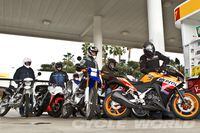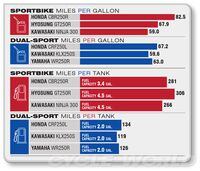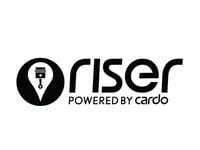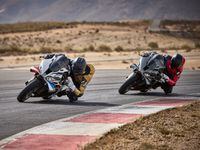One of the primary appeals of owning a small-displacement motorcycle is the savings such machines typically offer at the gas pump. To determine optimal motorcycle mpg figures and see how these bikes compare in the real world, we laid out a 60-mile test loop comprised of equal parts freeway, rural and city riding.
We weren't seeking the absolute best mileage possible, so we did not employ petrol-pinching tactics such as drafting, riding at a dangerously slow pace or switching off the engine at traffic signals. Rather, we sought a more real-world result indicative of "normal," albeit conservative, riding behavior. We rode at the posted speed limit throughout the route, ranging from 65 mph on the freeway to a low of 35 mph in town. We accelerated away from stops at a moderate rate, changing up through the gears at midrange revs. GPS monitored speed and distance to cover for the optimistic inaccuracy typical of many motorcycle speedometers.
Of the bikes we tested, the Honda CBR250R had the only accurate speedometer and odometer, with readings that were spot-on with our GPS. The CRF250L was a close second, its speedo reading only 1 mph over at a true 65 mph. The Kawasaki Ninja 300 also was good: its speedo only 2 mph optimistic at 65 mph. On the other end of the spectrum, the Hyosung GT250R, Kawasaki KLX250S and Yamaha WR250 each indicated 72 mph at an actual 65. That’s nearly 11 percent error, although it might help you avoid a speeding ticket.
At the conclusion of our ride, with all bikes refueled and numbers crunched, the Honda CBR250R established itself as our clear fuel-economy champ, returning an impressive 82.5 mpg, 14.6 mpg better than the runner-up Hyosung. Nevertheless, all the bikes in our test proved this point: Small-displacement motorcycles, when ridden casually, using relatively small throttle openings, are remarkably efficient.
Illustration by Tim Barker


/cloudfront-us-east-1.images.arcpublishing.com/octane/AAN4TI76M5H5JMUVEIGASWXBDU.jpg)
/cloudfront-us-east-1.images.arcpublishing.com/octane/P3RXD2UCPFF37CMB7CHPVKXORY.jpg)
/cloudfront-us-east-1.images.arcpublishing.com/octane/VZEG2EJI2RDFZNHLRZMU56MD3Q.jpg)
/cloudfront-us-east-1.images.arcpublishing.com/octane/GVJQO5FFOFBWNGODOBRB4FBAW4.jpg)
/cloudfront-us-east-1.images.arcpublishing.com/octane/BIVAK2SFIBDJJM25E7I5VU2FJE.jpg)
/cloudfront-us-east-1.images.arcpublishing.com/octane/CH5VX52UG5CFHOVH5A6UYEFWWA.jpg)
/cloudfront-us-east-1.images.arcpublishing.com/octane/ZVGJNGZRU5C33N7KN23BBFKSC4.jpg)


/cloudfront-us-east-1.images.arcpublishing.com/octane/CZ5OM3E43ZEXJHY7LCYXCHLIKI.jpg)
/cloudfront-us-east-1.images.arcpublishing.com/octane/DF5T4K5KPZFJXFCTGPYR77PKJM.jpg)
/cloudfront-us-east-1.images.arcpublishing.com/octane/RMCT2KVQBJHBZMRTSLOVPMOILU.jpg)

/cloudfront-us-east-1.images.arcpublishing.com/octane/K45KB2XHQVA65DX7VN4ZSMT2BI.jpg)
/cloudfront-us-east-1.images.arcpublishing.com/octane/FNHXQQ56BRD7TO4YIJ453PNG2M.jpg)
/cloudfront-us-east-1.images.arcpublishing.com/octane/OIKJC4JA3ZH7BMKUGWYKBIY5FA.jpg)
/cloudfront-us-east-1.images.arcpublishing.com/octane/MT2SAEWY6FDXFBYSLDE3AEFDTM.jpg)
/cloudfront-us-east-1.images.arcpublishing.com/octane/66UPKPYVURBPRCP5HXSN56MEMM.jpg)
/cloudfront-us-east-1.images.arcpublishing.com/octane/EOREGDSRKFDCRJC6K3EDVHBGCE.jpg)
/cloudfront-us-east-1.images.arcpublishing.com/octane/42RF63Q3LVCMBP3DGTWXFYSMOA.jpg)
/cloudfront-us-east-1.images.arcpublishing.com/octane/XNVY3EVWZFCEVPUGJGAN633LXE.jpg)
/cloudfront-us-east-1.images.arcpublishing.com/octane/2PLTVHXY7FDSPFHKU5CFOC43ZY.jpg)
/cloudfront-us-east-1.images.arcpublishing.com/octane/B6M3WTRLFZGNXBEATNXPVGBBD4.jpg)
/cloudfront-us-east-1.images.arcpublishing.com/octane/4CMH3FI73BEM5D6MFYX42FLDSQ.jpg)